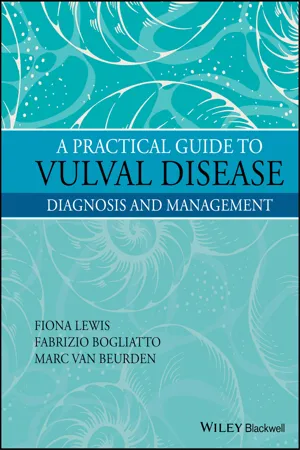
A Practical Guide to Vulval Disease
Diagnosis and Management
- English
- ePUB (mobile friendly)
- Available on iOS & Android
A Practical Guide to Vulval Disease
Diagnosis and Management
About This Book
A PRACTICAL GUIDE TO VULVAL DISEASE DIAGNOSIS AND MANAGEMENT
A PRACTICAL GUIDE TO VULVAL DISEASE DIAGNOSIS AND MANAGEMENT
Patients with vulval disease frequently experience delays in diagnosis due to a lack of training for physicians. A Practical Guide to Vulval Disease: Diagnosis and Management offers practical, up-to-date and expert guidance on the diagnosis and management of vulval disorders. It provides the knowledge required for diagnosis and treatment of these conditions at both trainee and specialist level. Key information about diagnosis, investigation and basic management is included, with a section on signs and symptoms to direct the reader to the appropriate chapter for the particular disease. Current classification and terminology of vulval disease is featured, along with guidance on when a patient should be referred to a specialist.
Well illustrated, with 185 high quality photographs, this user-friendly clinical guidebook integrates clinical and histological features of vulval disorders, so the reader can understand the disease from a microscopic to macroscopic level.
Written by an experienced author team, A Practical Guide to Vulval Disease: Diagnosis and Management is essential reading for gynaecologists, dermatologists, genito-urinary physicians, general practitioners and nurses, both in practice and in training.
Frequently asked questions
Information
1
The Normal Vulva
- ectoderm (squamous epithelium);
- mesoderm (connective epithelium);
- endoderm (vulval vestibule).
Normal vulval anatomy





Table of contents
- Cover
- Title Page
- Table of Contents
- Acknowledgements
- 1 The Normal Vulva
- 2 Taking a History and Examination
- 3 How to Take a Vulval Biopsy and the Importance of Clinico-Pathological Correlation
- 4 Basic Histology of the Vulva
- 5 Investigations in Vulval Disease
- 6 Topical Treatment in Vulval Disease
- 7 Symptoms in Vulval Disease
- 8 Signs in Vulval Disease
- 9 Eczema, Allergy and the Vulva
- 10 Psoriasis
- 11 Lichen Simplex
- 12 Lichen Sclerosus
- 13 Lichen Planus
- 14 Hidradenitis Suppurativa and Crohn's Disease
- 15 Disorders of Pigmentation on the Vulva
- 16 Other Dermatoses
- 17 Vulval Infection – Sexually Transmitted
- 18 Vulval Infection – Nonsexually Transmitted
- 19 Vulval Intraepithelial Neoplasia
- 20 Extramammary Paget’s Disease
- 21 Vulval Squamous Cell Carcinoma
- 22 Other Vulval Cancers
- 23 Vulvodynia
- 24 Psychosexual Aspects of Vulval Disease
- 25 Benign Lesions
- Index
- End User License Agreement